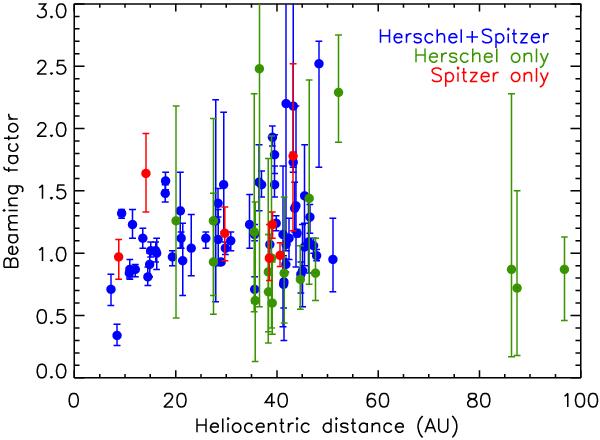"TNOs are Cool": A survey of the trans-Neptunian region. IX. Thermal properties of Kuiper belt objects and Centaurs from combined Herschel and Spitzer observations
Abstract
Aims: The goal of this work is to characterize the ensemble thermal properties of the Centaurs / trans-Neptunian population.
Methods: Thermal flux measurements obtained with Herschel/PACS and Spitzer/MIPS provide size, albedo, and beaming factors for 85 objects (13 of which are presented here for the first time) by means of standard radiometric techniques. The measured beaming factors are influenced by the combination of surface roughness and thermal inertia effects. They are interpreted within a thermophysical model to constrain, in a statistical sense, the thermal inertia in the population and to study its dependence on several parameters. We use in particular a Monte-Carlo modeling approach to the data whereby synthetic datasets of beaming factors are created using random distributions of spin orientation and surface roughness.
Results: Beaming factors η range from values <1 to ~2.5, but high η values (>2) are lacking at low heliocentric distances (rh < 30 AU). Beaming factors lower than 1 occur frequently (39% of the objects), indicating that surface roughness effects are important. We determine a mean thermal inertia for Centaurs/ TNO of Γ = (2.5 ± 0.5) J m-2 s-1/2 K-1, with evidence of a trend toward decreasing Γ with increasing heliocentric (by a factor ~2.5 from 8-25 AU to 41-53 AU). These thermal inertias are 2-3 orders of magnitude lower than expected for compact ices, and generally lower than on Saturn's satellites or in the Pluto/Charon system. Most high-albedo objects are found to have unusually low thermal inertias. Our results suggest highly porous surfaces, in which the heat transfer is affected by radiative conductivity within pores and increases with depth in the subsurface.
- Publication:
-
Astronomy and Astrophysics
- Pub Date:
- September 2013
- DOI:
- 10.1051/0004-6361/201322047
- Bibcode:
- 2013A&A...557A..60L
- Keywords:
-
- Kuiper belt: general;
- planetary systems;
- planets and satellites: surfaces;
- methods: observational;
- techniques: photometric
